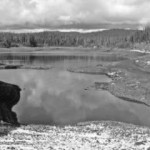We’ve had an early warning.
Skis are scraping rocks in the mountains around the Okanagan Valley where they normally wouldn’t at this time of year.
The monthly measurements of accumulated snow at higher elevations is well below normal at some sites.
At other places, it’s just below the usual amount, but note that it is below normal.
It’s estimated that half the winter’s snowfall has piled up by now, but there’s still a chance for things to turn around with some unusually heavy storms.
But, good snow depth at higher elevations in this watershed is vital to our health and well-being later in the year, when the true desert nature of this valley becomes apparent.
As we get past June, historically the wettest month in the Okanagan, the green grasses that sprouted on our sagebrush-strewn hillsides in spring turn to brown and the delicate yellow of the cactus blossoms stand out against a background of dry and dusty ground.
Seeing that makes you realize how out of place lush green lawns are in this arid valley.
To counteract the lack of precipitation here, we have created a complex network of bowls above the valley to capture winter’s snows as they melt, before the meltwater rushes down to the big lake in the valley bottom.
That stored water is released gradually, as needed, for gravity to carry it downhill to water crops and keep humans alive on the lower slopes near the valley’s bowl.
However, when those vital reservoirs of water dry up, the crops and the people downstream will too.
In the past, some have been nonchalant about the problems posed by a shortage of water.
They’ve drilled wells to tap into underground aquifers, bypassing the system of licenses for surface water sources such as lakes and streams.
What wasn’t realized is that all the valley’s water is interconnected.
Underground reservoirs of water are called aquifers and their sources are not much different from that of above-ground reservoirs.
Aquifers are connected to each other and they’re reliant on streamflows as well as precipitation.
Sometimes they’re even dependent on irrigation (perhaps mixed with fertilizers), and on stormwater runoff in urban areas (which may carry an array of pollutants from fuels to chemical spills).
In the Okanagan Valley we’re just beginning to collect data about the connections between water sources underground; the quantity that’s stored there and just where; and how those sources are recharged or refilled with water when we deplete them.
Without that information, we shouldn’t continue to use more water, because we can’t plan for future use.
In years like this, when we’ve already had an early warning, we should be hoarding water, conserving it wherever possible.
There is a limited and relatively small amount of water that replenishes our various sources each year in this dry valley. Once they’re gone, so are we.
Consider yourself warned.
Judie Steeves writes about outdoors issues for the Capital News.

